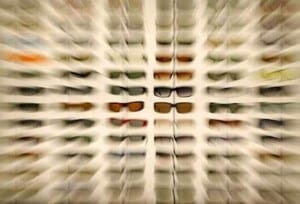The Right Sunglasses
Sunglasses are worn mainly to eliminate the discomfort and disabling effects of bright light and to protect against ultraviolet and infrared radiation. The need for sunglasses varies because people differ in the extent to which they tolerate bright light and in their occupational and recreational activities.
When sunglasses should be worn
Sunglasses are designed for outdoor day time wear in bright sunshine or where there is glare. They should be worn when bright sunlight causes watering of the eyes, squinting or excessive blinking.
Sunglasses are essential during periods of prolonged exposure to sunlight. Besides visible light, sunlight contains two powerful, invisible forms of radiation – ultraviolet and infrared. Continued exposure to these rays can cause serious eye damage.
Optometrists recommend that people who spend most of their time outside or who work near snow, water or sand should wear sunglasses that filter out both ultraviolet and infrared rays. Because the effects of exposure to UV accumulate over a person’s lifetime, it is important for children as well as adults to wear eye protection.
Sunglasses should not be worn at night, particularly while driving. This is because in the dark they can reduce vision to dangerously low levels. A driver could easily miss seeing a pedestrian or a parked car.
If you feel that you need to wear sunglasses continually for comfort, you should consult your optometrist – you may have a problem with your eyes or vision.
Differences between types of sunglass lenses
There are different kinds of sunglass lenses.
- Tinted Made of glass or plastic, tinted lenses come in a variety of shades. To be effective they should screen out 75 to 90 per cent of available visible sunlight. Grey tints do not affect the colours you see and are the best choice where colour accuracy is important. Glass lenses with green tints are usually the best infrared filter. Lightly tinted fashion lenses do not screen out sufficient light to be properly classified as sunglasses.
- Polarising Usually plastic polarising lenses are effective in combating the glare caused by light reflected from the road or from water. They screen out ultraviolet rays. Prescription Polaroid lenses are also available. Drivers should note that dark blotches appear on some safety windscreens when looking through polarising sunglasses.
- Photochromic Commonly called sun-sensitive light sensitive or light sensitive lenses, photocromic lenses darken or change colour as the sun gets brighter. To ensure sufficient darkening in sunlight, only quality Photochromic lenses should be worn and 75 to 90 per cent of available sunlight should be screened out.
- Reflecting A thin metallic coat is combined with tinted lenses to produce a mirrored appearance. They are designed for wear under intense glare such as sunlight reflected from water or snow. Some absorb both ultraviolet and infrared rays.
What to look for in sunglasses
Make sure that the lenses:
- Conform to the Australia standard, which specifies that the glasses are manufactured from quality ophthalmic materials
- Screen out ultraviolet light
- Are ground and polished to be free of distortion and imperfection
- Are perfectly matched in colour and absorptive power
- Match your prescription if you usually wear spectacles out of doors
- Are large enough to provide ample protection
- Are made from the material best suited to your needs
Plastic lenses are generally more impact resistant than glass and lighter in weight. However, they scratch more easily unless they have a scratch-resistant coating and, unlike some glass lenses, do not filter out infrared rays.
Check that the frame is of sturdy construction and does not interfere with side vision.
Sunglass standards
Sunglass standards became law in Australia on 1 October 1985. Under the Standard, sunglasses are divided into three main categories and labeled for the information of consumers.
- General purpose sunglasses are intended to reduce glare in ordinary circumstances and are suitable for everyday use in situations such as driving a car
- Specific purpose sunglasses are required to meet more stringent standards and are intended for use in activities such as skiing or yachting
- Fashion spectacles do not provide significant protection against sun glare and are intended for decorative rather than protective purposes
Some sunglasses are also labeled ‘Not suitable for colour defective persons’ or ‘Not suitable for driving’.










